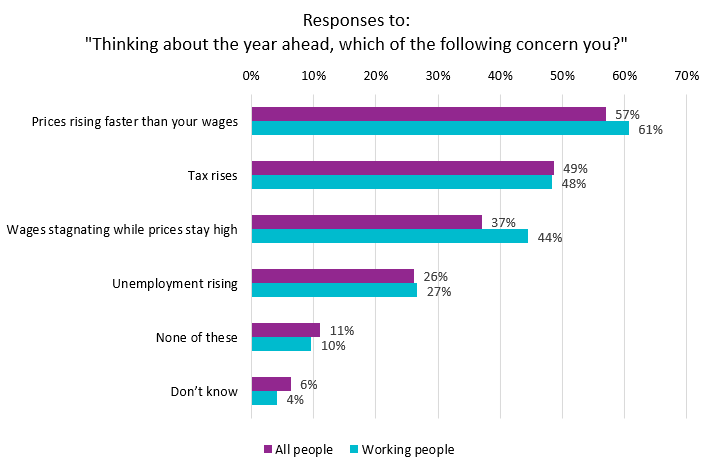A new survey by the British Retail Consortium (BRC) suggests
growing concerns about the cost of living in the year ahead. The
survey of 2,000 people, conducted by Opinium, found people's
biggest concern was “prices rising faster than wages”, with 57%
of respondents agreeing (61% among working people). This was
higher than concerns around tax rises (49%) and rising
unemployment (26%).
The latest figures by the ONS show that inflation is now 3.8%,
almost double the Bank of England's target of 2%. This was even
higher for food inflation, which rose to 4.9%, the highest level
since the cost of living crisis in 2022/23.
Retail price inflation has been rising steadily over the last
year, accelerated by the impact of the previous Budget, which
significantly increased employment costs, as well as introducing
a new packaging tax on retail businesses.
Last week, the Bank of England held off from an interest rate cut
on fears that rising food prices were putting upwards pressure on
headline inflation. The last Budget added £7 billion to retailers
costs as a result of rises to employer NICs, higher NLW and a new
packaging tax, so it was no surprise that the latest MPC
minutes blamed rising food prices on “labour costs and
costs associated with new packaging regulation” as well as higher
commodity prices.
The BRC is warning that food inflation will rise and remain above
5% well into 2026 if the retail industry is hit by further tax
rises at the Autumn Budget. The Government has pledged to bring
down business rates for retail, hospitality and leisure premises,
but around 4,000 large shops could actually see their rates rise,
if they are included in the Government's new business rates
surtax for properties with a rateable value over £500,000.
Helen Dickinson, Chief Executive at the British Retail
Consortium, said:
“The Government risks losing the battle against inflation and
working families are understandably worried. With many people
barely recovering from the last cost of living crisis, the
Chancellor will want to protect households and enable retailers
to continue doing everything they can to hold back prices.
“The Treasury is currently finalising its plans to support the
high street, including a much-needed reduction in business rates
for retail, hospitality and leisure premises. However, the
biggest risk to food prices would be to include large shops –
including supermarkets – in the new surtax on large properties.
This would effectively be robbing Peter to pay Paul, increasing
costs on these businesses even further and forcing them to raise
the prices paid by customers. Removing all shops from the surtax
can be done without any cost to the taxpayer, and would
demonstrate the Chancellor's commitment to bring down inflation.”

-ENDS-
Survey Methodology:
Polling conducted by Opinium for the BRC. Sample included 2,000
UK adults and results have been weighted and assigned a net
score. Respondents were asked “Thinking about the year ahead,
which of the following concern you. Please tick all that
apply.”
Business Rates Reform - Background:
- Currently, all non-domestic premises pay Business Rates (or
Non-Domestic Rates in Scotland). They are calculated by
Multiplier (tax rate) x Rateable Value of a property. In England,
the multipliers are 55.5p (in the pound) for most business
premises, and 49.9p for small business premises (rateable value
under £51,000).
- Labour came into Government with a pledge to reform business
rates. They are planning a permanent reduction in the business
rates multiplier for retail, hospitality and leisure (RHL)
premises, with a rateable value of under £500,000. We do not yet
know what the new lower multipliers will be for RHL premises.
- This will be paid for by the introduction of a new, higher,
multiplier for all premises with a rateable value of over
£500,000. We do not yet know how much the new multiplier is.
- The BRC has calculated that shops could be excluded from the
higher multiplier (RV>£500k), with only a slight increase to
the multiplier for all other large properties in this bracket
(e.g. large office blocks).
